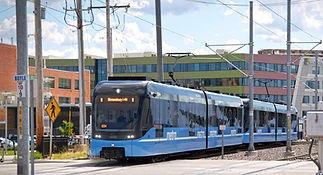Summary
Columbus is one of the largest cities in North America without any kind of rail service for people, whether it be passenger, heavy, or light rail according to 614Now.
This presents a lot of problems for the city. Columbus is one of the most rapidly growing cities in the U.S. along with the Central Ohio region as a whole. This growth is going to mean more people, and with more people comes more congestion, density, and difficulty getting around.
Of course – that’s only when we don’t have ways to efficiently move large amounts of people. Well thought out mobility options allow people to be moved from points A to Z instead of only A to B.
This presents a unique opportunity for Columbus. If done right, this growth can provide new opportunities for businesses, communities, and individuals. But with its current growth, the present transportation options do not provide the mobility needed for a population increase to 3.15 million residents in Central Ohio by 2050.
Columbus' solution? Issue 47, also known as LinkUS.
The Project
This new project is a collaborative effort between the Central Ohio Transit Authority (COTA), the Franklin County Board of Commissioners, the Mid-Ohio Regional Planning Commission (MORPC), the City of Columbus, and the Columbus Partnership aimed at providing better transportation options for Central Ohio and Columbus.
Here are the improvements planned:
- 45% more COTA service - More sidewalks, bike lanes, trails, and crosswalks - Bus Rapid Transit lanes - Bus station improvements
The improvements made will not only improve transportation in Columbus, but also provide people with a better quality of life. Faster bus transportation and dedicated bus lanes will help make them competitive with drive times in Columbus, allowing more people to use public transit to get around. This takes cars off of roads, removing some of the strain roads deal with from daily use. With this, Columbus would not just help move people – it would save money on critical infrastructure that is used daily.

LinkUS Implementation
So, how will COTA provide this expanded service?
First, they will use the existing 492 bus fleet that provides service to Central Ohio. This service will not be reduced, and it will still serve the 11 million trips made on COTA in 2023.
Next, the agency will provide 8 new Plus Zones, which are on-demand transit areas that provide transportation to people on request. These zones are crucial to those with disabilities or limited mobility, and expanding them gives people greater access to this service.
Finally, COTA will implement 5 Bus Rapid Transit (BRT) routes. These BRT routes will be used to provide quick and efficient service to people in high-ridership corridors, providing people with a faster way to get around in a faster way than traditional bus services. Here’s how they’ll do that:
Increased capacity, zero-emission vehicles
Level-and multi-door boarding
Off-board fare collection
Signal priority and intersection control
Dedicated transit lanes
Improved stations with amenities
Although we tend to hear calls for rail transit, the BRT routes are a great step in the right direction for more efficient and fast service in Columbus and beyond. BRT works similarly to light rail or a metro system, and would accomplish a lot, such as:
Right of way: they get where they need to go faster with their own dedicated lanes.
A quick trip: buses stay in the center or in their own corridors, bypassing congested traffic
Convenience: off-board fare collection will speed up the boarding process just like heavy or light rail does.
Efficient boarding: platform level boarding means you step on and off quickly, unlike the slower process for traditional buses.
What does this mean? It means that with BRT, you get the same experience and benefits of a rail system on rubber, which is going to come to Columbus much quicker. Bringing these major benefits for folks in Central Ohio will showcase the value of public transportation, and pave the way for future advocacy around a dedicated Columbus rail system that serves the region. Any step forward is progress, and with BRT, we get a solid step forward.

Along with the proposed changes in LinkUS, there is also going to be plans for how the proposed Amtrak routes in Ohio, such as the 3C and D route and the Midwest Connect. The Mid Ohio Regional Planning Commission (MORPC) discussed the ways these routes will tie into the proposed changes with LinkUS, namely the intersection of Amtrak routes and Bus Rapid Transit at the Columbus Convention Center on High Street. Currently, this proposed station is deemed to be very feasible, and would be nearby a lot of amenities in downtown Columbus.
These quality of life changes will have an immediate impact on peoples travel using COTA. By focusing on the many components of transportation like biking, walking, riding, or on-demand service, LinkUS closes gaps. People will get where they need to go faster, and it’ll be done in a way that’s better for the environment, businesses, and people.
So, how can community members get involved?
There are three planned townhalls in September and October 2024 being hosted by the organizations in-charge of LinkUS, and getting public feedback in support of this project will go a long way in making sure Columbus and all of Central Ohio gets the rapid transit and walkability it deserves. To view the upcoming townhalls and register, fill out this form.
ABOUT ALL ABOARD OHIO
All Aboard Ohio is a non-profit, member-based organization dedicated to promoting improved public transportation and passenger rail service throughout the state.
Founded in 1973 and incorporated as a registered 501c-3 in 1987, All Aboard Ohio has spent more than 50 years advocating, educating, and working towards our goal of a connected Midwest
All Aboard Ohio is a 501c-3 nonprofit with over 50 years of advocacy work, advocating for improved public transportation and passenger rail service in the Midwest
©2025 by All Aboard Ohio
Get in Touch
3136 Kingsdale Center,
#112 Columbus, OH 43221
Federal Tax ID: 31-1066182










